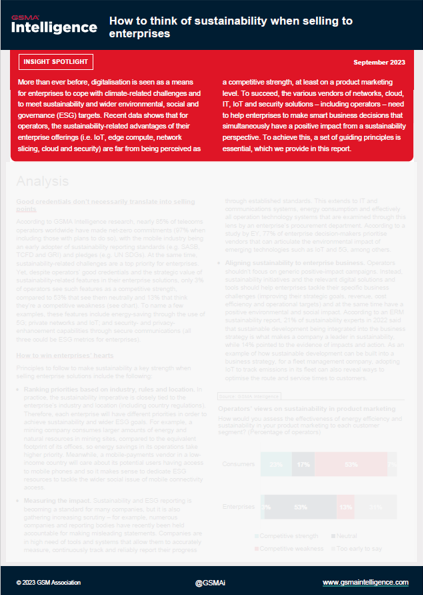How to think of sustainability when selling to enterprises

This insight is available to those subscribed to the IoT & Enterprise module.
Report details
How to think of sustainability when selling to enterprises
More than ever before, digitalisation is seen as a means for enterprises to cope with climate-related challenges and to meet sustainability and wider environmental, social and governance (ESG) targets. Recent data shows that for operators, the sustainability-related advantages of their enterprise offerings (i.e. IoT, edge compute, network slicing, cloud and security) are far from being perceived as a competitive strength, at least on a product marketing level. To succeed, the various vendors of networks, cloud, IT, IoT and security solutions – including operators – need to help enterprises to make smart business decisions that simultaneously have a positive impact from a sustainability perspective. To achieve this, a set of guiding principles is essential, which we provide in this report.
Report details
How to think of sustainability when selling to enterprises
Related research
Taiwan Mobile: Structuring a comprehensive telco financial services offering with digital-native partners
Operator strategies continue to evolve in the digital era as the telecoms industry seeks to capture new growth opportunities in the consumer and enterprise markets. Assessing innovation and achievements is more important than ever before. GSMA Intelligence's operator case studies provide a concise and consistent way to shine a light on and analyse operators' strategies and business models, as well as how they are launching new services. This edition explores how Taiwan Mobile is expanding telco financial services as part of its 'Telco+Tech' upgrade strategy.
Singtel: Advancing enterprise security through a hybrid quantum-safe network managed service
Operator strategies continue to evolve in the digital era as the telecoms industry seeks to capture new growth opportunities in the consumer and enterprise markets. Assessing innovation and achievements is more important than ever before. GSMA Intelligence's operator case studies provide a concise and consistent way to shine a light on and analyse operators' strategies and business models, as well as how they are launching new services. This edition looks at Singtel's managed security service for enterprises to help protect them against emerging quantum threats.
KDDI: Expanding platform solutions for businesses in the AI era by leveraging core telco and digital assets
Operator strategies continue to evolve in the digital era as the telecoms industry seeks to capture new growth opportunities in the consumer and enterprise markets. Assessing innovation and achievements is more important than ever before. GSMA Intelligence's operator case studies provide a concise and consistent way to shine a light on and analyse operators' strategies and business models, as well as how they are launching new services. This edition analyses KDDI's enterprise portfolio strategy, including the expansion of its business platform for AI.
Authors
How to access this report
Annual subscription: Subscribe to our research modules for comprehensive access to more than 200 reports per year.
Enquire about subscriptionContact our research team
Get in touch with us to find out more about our research topics and analysis.
Contact our research teamMedia
To cite our research, please see our citation policy in our Terms of Use, or contact our Media team for more information.
Learn moreRelated research
Taiwan Mobile: Structuring a comprehensive telco financial services offering with digital-native partners
Operator strategies continue to evolve in the digital era as the telecoms industry seeks to capture new growth opportunities in the consumer and enterprise markets. Assessing innovation and achievements is more important than ever before. GSMA Intelligence's operator case studies provide a concise and consistent way to shine a light on and analyse operators' strategies and business models, as well as how they are launching new services. This edition explores how Taiwan Mobile is expanding telco financial services as part of its 'Telco+Tech' upgrade strategy.
Singtel: Advancing enterprise security through a hybrid quantum-safe network managed service
Operator strategies continue to evolve in the digital era as the telecoms industry seeks to capture new growth opportunities in the consumer and enterprise markets. Assessing innovation and achievements is more important than ever before. GSMA Intelligence's operator case studies provide a concise and consistent way to shine a light on and analyse operators' strategies and business models, as well as how they are launching new services. This edition looks at Singtel's managed security service for enterprises to help protect them against emerging quantum threats.
KDDI: Expanding platform solutions for businesses in the AI era by leveraging core telco and digital assets
Operator strategies continue to evolve in the digital era as the telecoms industry seeks to capture new growth opportunities in the consumer and enterprise markets. Assessing innovation and achievements is more important than ever before. GSMA Intelligence's operator case studies provide a concise and consistent way to shine a light on and analyse operators' strategies and business models, as well as how they are launching new services. This edition analyses KDDI's enterprise portfolio strategy, including the expansion of its business platform for AI.
- 200 reports a year
- 50 million data points
- Over 350 metrics
